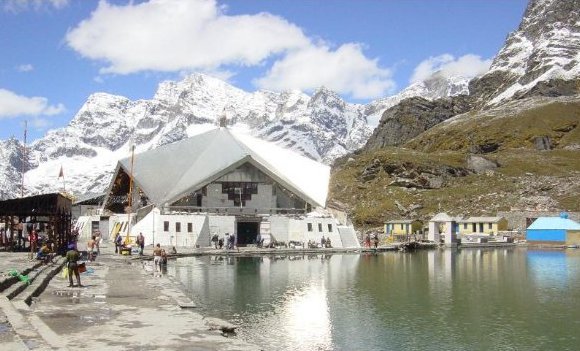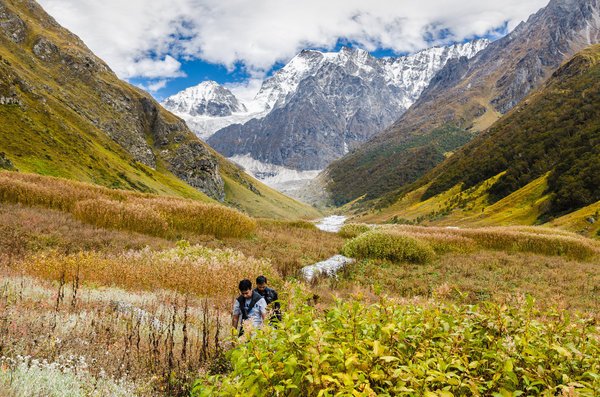
May 31, 2013: Deep in the gorge that it carves through the Himalayas, the Alaknanda River rushed beneath a footbridge. On the right bank sat a busy Indian village, Govindghat, its one street lined with spartan hotels and shops brimming with Sikh religious items and souvenirs. On the left bank, a man wearing a frayed sweater-vest and a ski cap greeted me imploringly.
“Horse?” he asked, hoping I would hire his mules to haul me and my pack up the path to Ghangaria, an isolated mountain hamlet in Uttarakhand state. Ghangaria is the base for visiting the legendary Valley of Flowers National Park — where some 300 varieties bloom in peak season — and Hemkund, a lake and sacred Sikh pilgrimage site in the Garhwal Himalayas.
“Horse?” he repeated. “Five hundred rupees...”
I thought about it. Ghangaria can be reached only by foot, hoof or helicopter (the latter being way beyond my budget). The route is about eight miles long and climbs some 4,000 feet, to 10,006 feet above sea level. It was already afternoon and I’d eaten only a few biscuits that morning. But it was a brilliantly sunny day and I felt energetic. Even as the price dropped to 400 rupees — less than $8 — I declined and headed up the first set of switchbacks, knowing I could eat Maggi masala (Indian ramen noodles) at a trailside stand and hire a “horse” along the way if I changed my mind. (Eventually, I did).
The cobblestone trail rose through a valley flanked by steep, forested slopes, capped by bare cliffs. Below, the Lakshman Ganga — a tributary of the Alaknanda — surged with startling force, as glacial snowmelt poured down over huge boulders.
Between early June and early October — except when landslides triggered by monsoon storms block the mountain roads — hundreds of Sikh pilgrims tackle the trail each day. When I was there in late September, it flowed with people eager to worship at one of the holiest places in the Sikh religion. Many traveled as families, most of them headed by bearded men in colorful turbans. Some wore traditional kurtas or blue warrior robes, others wore jeans and sweatshirts. The most devout walked barefoot. Some who couldn’t manage the climb rode mules. Others sat on wooden litters carried on the shoulders of four men, or in wicker chairs hauled like backpacks by porters. The latter two options, I thought, surely belonged on a list of “stuff in India that you’d never see in the United States.”
Shortly before dusk I reached Ghangaria, where it was so cold I was soon wearing every piece of warm clothing I had with me. My hotel room, like all others in town, had no heat; hot water was available only in buckets, for a small fee. On the plus side, the bed was piled with blankets, and prices were negotiable (I paid 300 rupees, about $5.50 at 55 rupees to the dollar.)
By the time I set out for Hemkund the next morning many pilgrims were already on the trail. We’d have to climb another 4,000 feet in just four miles to reach the hallowed lake, which sits 14,200 feet above sea level. The place had to be special, really special, to inspire all of these people — most of whom wouldn’t be described as “outdoorsy” — to undertake this kind of trek. There was clearly something at stake here beyond sightseeing, which I reflected on as I hiked.

Pilgrimages, religious or otherwise, are inspired by stories — some true, some fictional and some in which fact and legend are seamlessly stitched together. Regardless of their veracity, these stories resonate. The places where the stories are set become salient landmarks in the geographies of our imaginations. They seem to call to us from within, urging us to go to them and promising to complete us in some way if we do. Think of Jerusalem or Mecca, ground zero or even Graceland; these are not mere dots on a map, but places loaded with meaning that draw travelers to them. And when we go — when we reach these places that through their stories have reached into us — it’s as though our inner world unites with the outer. At least for a little while.
The story behind Hemkund relates to the 10th and last Sikh guru, Gobind Singh, who lived from 1666 to 1708.  Arguably the religion’s most influential founding father, he introduced many of the practices that define the faith to this day. Gobind Singh wrote that in a previous life he had meditated at a mountain lake ringed by seven peaks; there, he had become one with God, physically as well as spiritually, before being reborn as the great guru.
Arguably the religion’s most influential founding father, he introduced many of the practices that define the faith to this day. Gobind Singh wrote that in a previous life he had meditated at a mountain lake ringed by seven peaks; there, he had become one with God, physically as well as spiritually, before being reborn as the great guru.
For centuries, the location of Hemkund remained a mystery, until it was rediscovered in 1934 by a retired army officer named Sohan Singh. It turned out to be a lake called Lokpal, which had long been holy to Hindus. These days, it’s estimated that upward of 150,000 people make it there each year.
Though I’d gone on personal pilgrimages before — to the village in Ukraine where my grandmother lived in a ghetto during World War II, and where much of her family perished; to the surreal desertscape of Wadi Rum, in Jordan, where T. E. Lawrence, my childhood hero, once roamed — I didn’t think of my trek to Hemkund in those terms. Here I was a tourist, not a pilgrim. But even to a nonbeliever, the allure of a sacred lake high in the Himalayas was irresistible. And as someone with an abiding interest in the world’s religions, I hoped to get some insight into what it meant to the Sikh faithful to reach their holy place, especially after what had to be endured to get there.
After hiking out of Ghangaria and following the serpentine trail up a mountain for two and a half hours, I reached the little lake surrounded by rocky peaks. People were immersing themselves in the freezing waters, eating dal (lentil soup) made by volunteer cooks at the langar, or communal kitchen, and resting. The mesmerizing rhythms of Sikh kirtans, or devotional songs, spilled from a gurdwara (temple) whose multi-angular pitched metal roof made it easy to mistake for a spaceship.

Michael Benanav for The New York Times
Hiking through the Valley of Flowers National Park in India. More Photos »
Inside, worshipers sat on a red carpet facing a golden canopy, beneath which a spiritual leader waved a feathered whisk over a copy of the holy Sikh scriptures. In front of him, a table was decorated with plastic flowers, 11 plush-toy tigers and one leopard. The pilgrims were exceedingly friendly, and many spoke English. They seemed pleased to see a foreigner and were happy to talk about their experiences.
“It’s inspirational,” said Sukhmeet Singh, who is Indian-born but now lives in Australia. He was traveling with his parents, his wife and two children. For him, the journey seemed as important as the destination; he compared it favorably to the Tony Robbins seminars he’d attended, saying that meeting the challenge of the trek made him feel as if he could accomplish anything.
Others echoed what he had said. One man told me that sick people dipped in the lake to “cure-ify” their illnesses. But most of those I talked to spoke of Hemkund as a place of purification, which would take them “away from all evils” and inoculate them against future ones for some time.
|
But even to a nonbeliever, the allure of a sacred lake high in the Himalayas was irresistible. And as someone with an abiding interest in the world’s religions, I hoped to get some insight into what it meant to the Sikh faithful to reach their holy place, especially after what had to be endured to get there. |
“I was like what you could call a playboy, into drinks and women, and I cut my hair,” he said. “I had a big ego problem. But last year I decided I had to change, to live right. And this helps. It’s the best thing I’ve ever done in my life.”
The effects of Hemkund, he said, would fill him with a lasting peace and keep him on a righteous path long after he returned home.
In midafternoon, I descended to Ghangaria for another frigid night’s stay.
The following morning, I hiked into Valley of Flowers National Park, just a couple of miles upstream along the Pushpawati River. The trail passed through a narrow canyon, which opened up into a landscape so sublime — and so different from the Ghangaria side of the slot — that I felt like I’d been transported to another world.
The three-mile-long valley was framed by walls of snow-crowned, cloud-scraping peaks. Ribbons of water plunged thousands of feet down sheer rock faces, then flowed across rolling meadows. The greens and yellows and browns and steel grays of the earth, flecked with myriad other colors, were constantly changing hues, as sheets of cirrus filtered the sun. I scanned the slopes, hoping for a glimpse of a snow leopard, bear or musk deer, but saw none.
The peak bloom, for which the valley is renowned, had passed. In July and August, during the monsoon season, the basin floor is said to be a rainbow of flowers, the equal of any botanical extravaganza in the world. When I was there, just a smattering of blossoms remained.
But I had no regrets: coming after the monsoon meant a much better chance of sunshine and a much smaller chance of being delayed — or worse — by an apocalyptic cloudburst. And the valley, flowers or not, was still an alpine paradise.
Very few people were there. Walking along the trail, alone and unobserved, I could succumb to pure awe with no taint of self-consciousness.
In a way, I experienced at the Valley of Flowers what the Sikh pilgrims sought from Hemkund. Maybe not purification but peace, and a sense of contact with something far greater than myself: the Himalayas.
Might I make a pilgrimage back to the valley in the future? Perhaps. It would be nice to see the flowers.
Hemkund is open from about June 1 to Oct. 5. Valley of Flowers National Park is open from June 1 to Oct. 31. Park admission for non-Indians is 600 rupees (about $11) for three days.
Michael Benanav is the author of “Men of Salt: Crossing the Sahara on the Caravan of White Gold.”
---------------------------------
Related Articles:
http://www.sikhnet.com/news/environmental-preservation-hemkund-sahib

